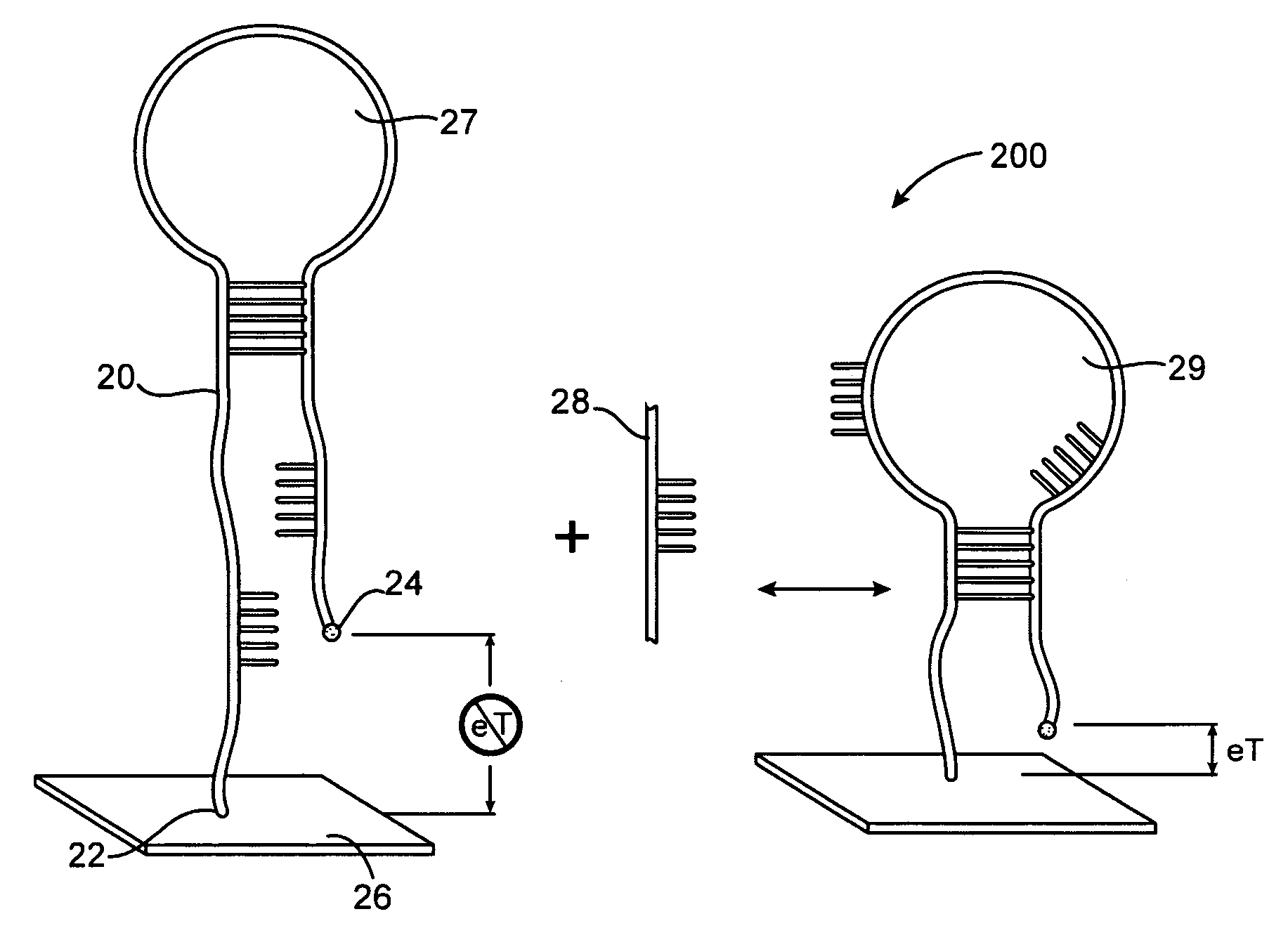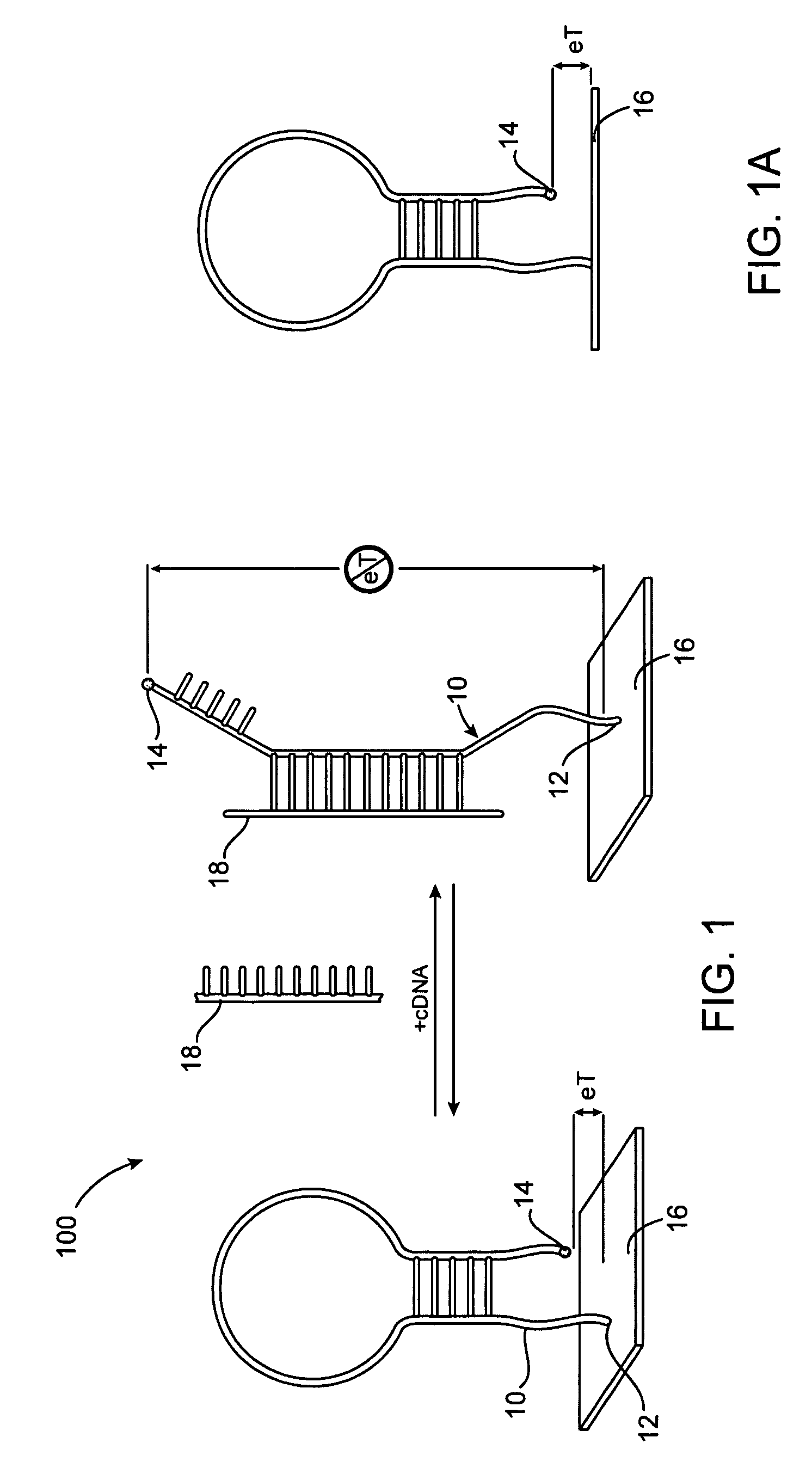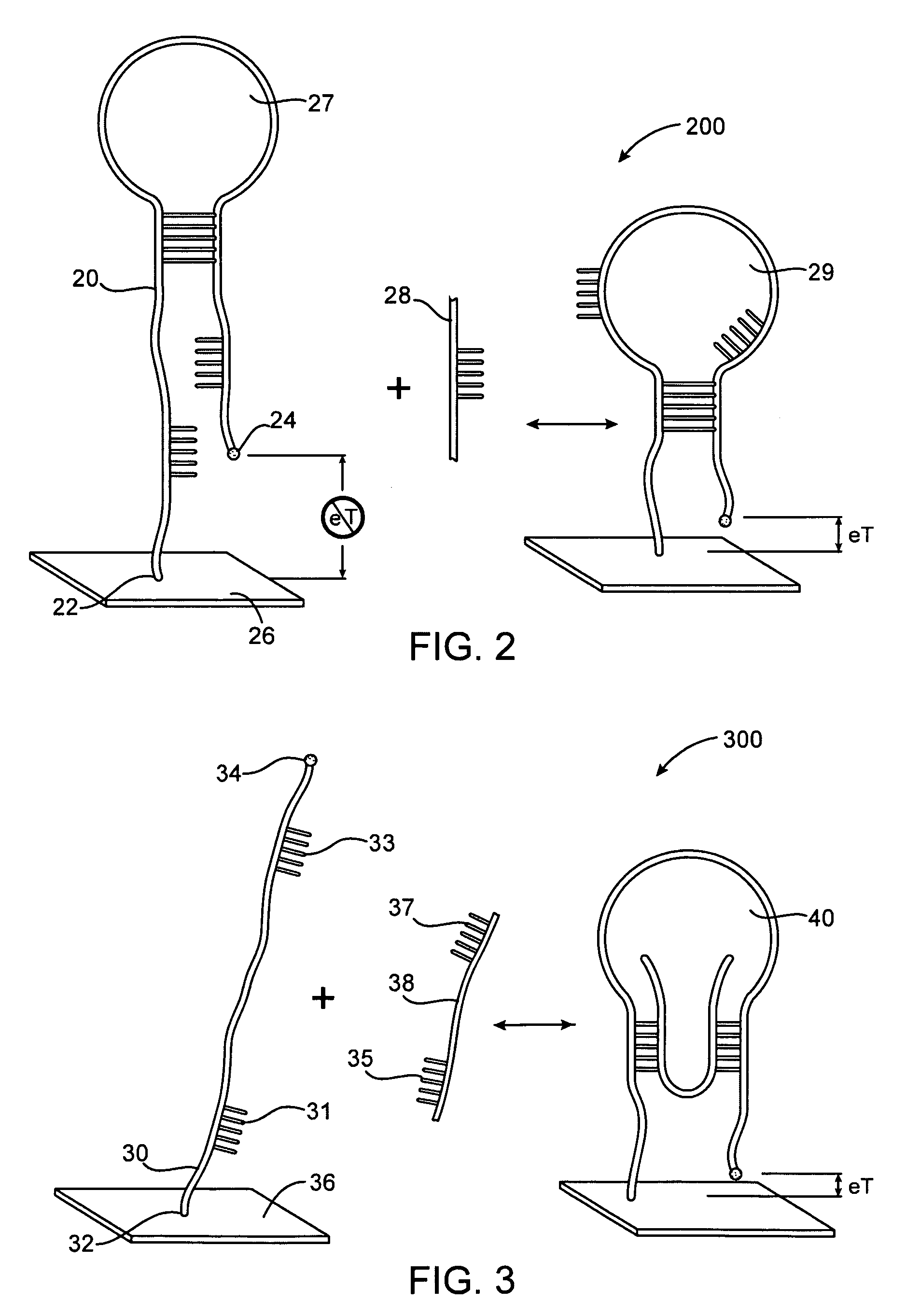Reagentless, reusable, bioelectronic detectors
a bioelectronic and detector technology, applied in the field of bioelectronic sensors, can solve the problems of no electronic sensor reported to meet the goal of fm sensitivity, the sensitivity of the sensor is only moderate, and the authentication method of existing dna-based authentication methods is limited to art, sports memorabilia and other high-value, low-volume applications
- Summary
- Abstract
- Description
- Claims
- Application Information
AI Technical Summary
Benefits of technology
Problems solved by technology
Method used
Image
Examples
example 1
Fabrication of the Stem-loop DNA Structure
[0093]Ferrocene carboxylic acid was purchased from Aldrich (Milwaukee, Wis.), 1-Ethyl-3-(3-dimethylaminopropyl)-carbodiimide (EDC) and N-hydrosuccinimide ester (NHS) were obtained from Sigma (Milwaukee, Wis.). Ferrocene succinimide ester (Fc-NHS) was prepared as described in the literature [Takenaka, S., Uto, Y., Kondo, H., Ihara, T. & Takagi, M. Anal. Biochem. 218, 436 (1994)] and confirmed by 1H NMR. Oligonucleotides were obtained from Synthegen (Houston Tex.). The sensor oligonucleotide, sequence 5′-NH2—(CH2)6-GCGAG GTA AAA CGA CGG CCA GT CTCGC-(CH2)6—SH-3′ (SEQ ID NO: 1) (oligo 1), contained a 5′ hexamethylene amine and a 3′ hexamethylene thiol group. Fc-NHS was dissolved in a small volume of dimethyl sulfoxide and then diluted in a 0.1 M Na2CO3 buffer (pH 8.5) containing 0.1 mM of oligo 1. This mixture was stirred overnight at room temperature. The final product (oligo 1-Fc) was purified by HPLC on a C18 column and confirmed by electros...
example 2
Preparation of the Functionalized Au Electrode
[0094]Polycrystalline gold disks (1.6 mm diameter; BAS Inc., West Lafayette, Ind.) were used as working electrodes. The protocol for gold electrode preparation has been previously described [Fan, C., Gillespie, B., Wang, G., Heeger, A. J. & Plaxco, K. W., J. Phys. Chem. (B) 106, 11375-11383 (2002)]. The cleaned gold electrode was rinsed, dried under argon and then immediately incubated overnight in 1 M oligo 1-Fc, 10 mM phosphate buffer with 0.1 M NaCl, pH 7.4. Prior to use, the oligo 1-Fc was pre-treated with tris-(2-carboxyethyl)phosphine to break disulfide bonds and then purified using a spin column. The modified electrode was washed with water, dried under argon and incubated in 1 M NaClO4 solution prior to use.
[0095]The gold surface was then functionalized by oligo 1 (see Example 1) through the well-established gold-S chemistry of self-assembly. Previous studies have demonstrated that this self-assembly process is only feasible in t...
example 3
Characterization of the E-DNA Modified Electrode
[0096]The stem-loop structure localizes the ferrocene tag in close proximity to the gold surface (see Example 2 and FIG. 1) and thereby ensures that the distance between the gold electrode and the ferrocene moiety is sufficiently short to promote electron transfer.
[0097]Cyclic Voltammetry (CV) was performed using a CHI 603 workstation (CH Instruments) combined with a BAS C-3 stand. A platinum electrode was used as a pseudo-reference electrode while potentials are reported versus the normal hydrogen electrode (NHE). Background subtraction was conducted in some cases using Origin 6.0 (Microcal Software, Inc.) in order to remove non-Faradayic currents and improve signal clarity [Fan, C., Gillespie, B., Wang, G., Heeger, A. J. & Plaxco, K. W., J. Phys. Chem. (B) 106, 11375-11383 (2002); Hirst, J. et al. J. Am. Chem. Soc. 120, 7085-7094 (1998). Bard, A. J. & Faulkner, L. R. Electrochemical Methods (John W. Willey & Sons, New York, 2001)]. A...
PUM
| Property | Measurement | Unit |
|---|---|---|
| pH | aaaaa | aaaaa |
| pH | aaaaa | aaaaa |
| ionic strength | aaaaa | aaaaa |
Abstract
Description
Claims
Application Information
 Login to View More
Login to View More - R&D
- Intellectual Property
- Life Sciences
- Materials
- Tech Scout
- Unparalleled Data Quality
- Higher Quality Content
- 60% Fewer Hallucinations
Browse by: Latest US Patents, China's latest patents, Technical Efficacy Thesaurus, Application Domain, Technology Topic, Popular Technical Reports.
© 2025 PatSnap. All rights reserved.Legal|Privacy policy|Modern Slavery Act Transparency Statement|Sitemap|About US| Contact US: help@patsnap.com



